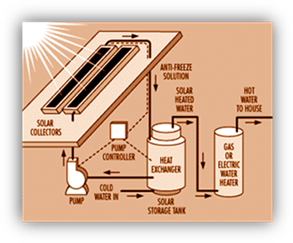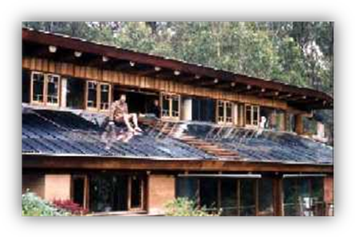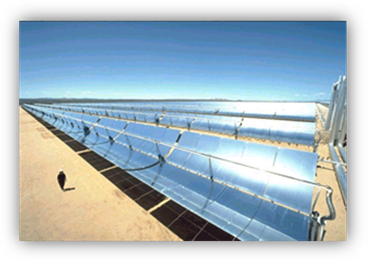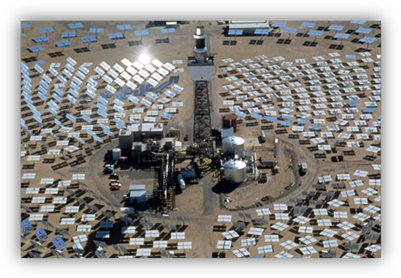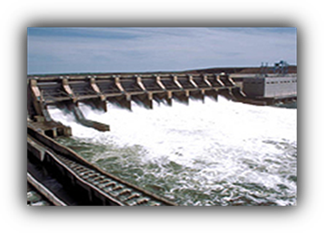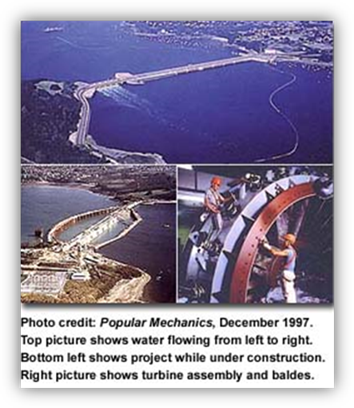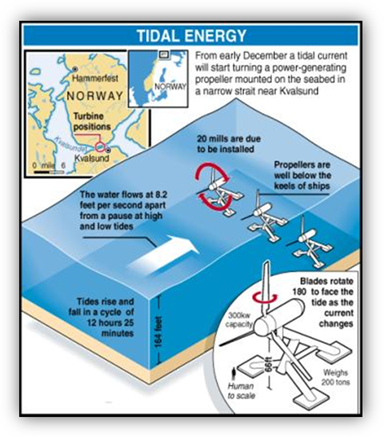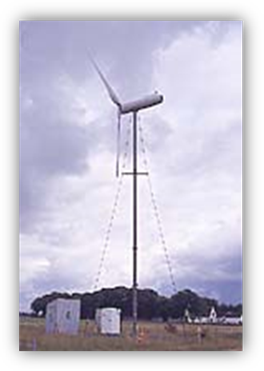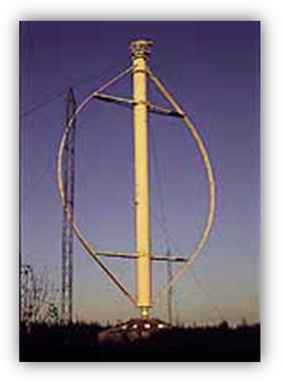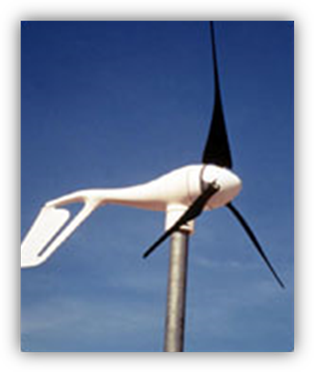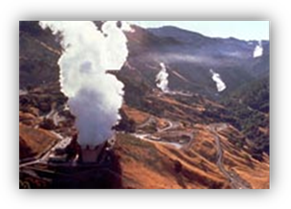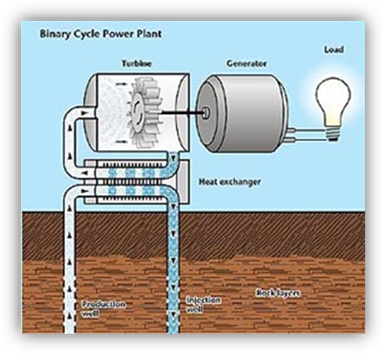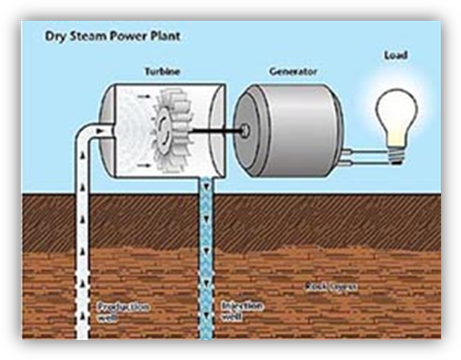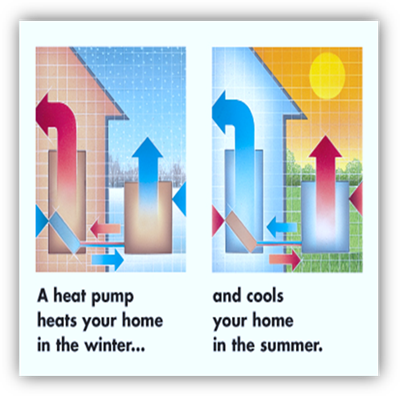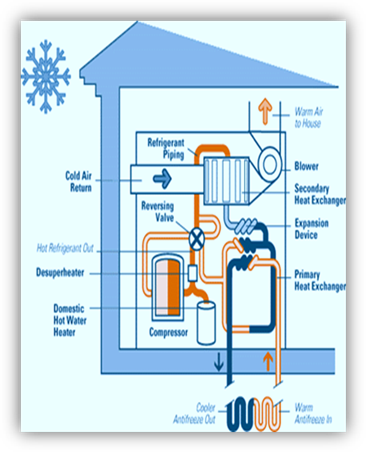RENEWABLE ENERGY SOURCES - HOW
THEY ARE USED
![j0189251[1]](SCI170U15Renewable_Used_image002.gif)
Unit Overview
Renewable
sources of energy will be defined and investigated in this unit. Their use in our society to provide our basic
needs for electricity, transportation, and heating will be discussed. The process of energy transformations from
the source to its use will be noted as well as the efficiency of those
transformations. Other energy
transformations in common household objects will also be noted.
In
the last unit we studied the nonrenewable energy sources, those which exist in
limited amounts and cannot easily be replaced.
Now we will study the renewable sources – wind, biomass, solar,
geothermal, hydro and ocean power.
Renewable resources are able to be replenished as long as the sun
continues to shine. Although these sources
of energy are used to supply only 7.6% of our energy at present, they may one
day be the answer to making us less dependent upon foreign energy sources and
conserving our limited supply of the nonrenewables. Usually, the renewables are less polluting as
well. Scientific research has been
ongoing to find a way to make these sources more efficient and less costly to
use. The goal is to have sustainable energy resources; that is,
resources that can continually be replenished and not run out. Within your lifetime, it is nearly certain
you will see a great increase in the use of these renewable sources.
Solar Energy
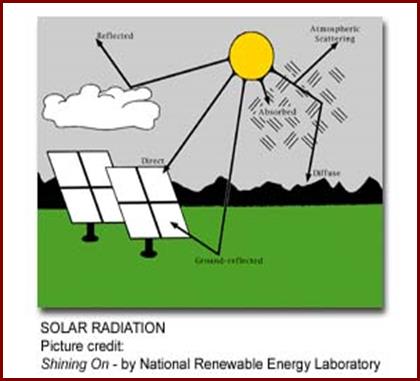
Solar energy is reflected from clouds and the
ground.
Some is scattered or absorbed. Only a small amount directly hits solar
panels.
The
first renewable source is one we are all familiar with, the sun. As we stated earlier, the sun is a huge
nuclear reaction sending out radiant energy throughout the solar system. Radiant energy travels in waves that move
very fast at 186,000 miles per second.
It only takes about 8 minutes for the light from the sun to reach Earth
over a distance of 93 million miles.
Only a small fraction of the sun’s energy strikes Earth because it
spreads out from the sun in all directions.
But, the amount of solar energy that strikes the United States daily is
enough to supply our energy needs for one-and-one-half years.
What
happens to all that energy? About 15%
hits the earth and is reflected back into space. You have seen light reflect off of
water. It can create a glare as it
bounces back into your eyes. Another 30% is used to evaporate water from
oceans, lakes, and other natural water sources.
This water eventually returns to Earth as precipitation. Some energy is absorbed by plants for
photosynthesis and by the land and oceans causing them to warm. The remaining energy could be used to supply
our energy needs.
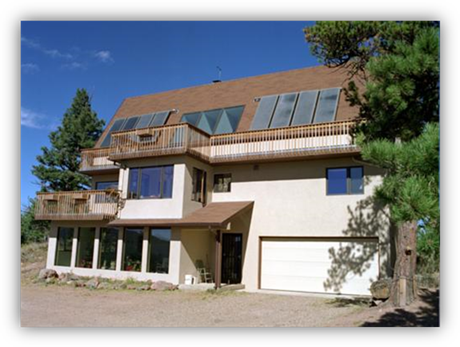
(above) This is an example of a
passive solar home. Notice all the south-facing windows and the overhang above
them
One
of the problems in harnessing solar energy is that it is spread out over the
entire surface of Earth, but it needs to be concentrated to produce more
heat. If the heat is to be used to heat
a home or a building, there are two ways which it can be accomplished. One method is passive solar heating. This
system uses no special devices, but relies upon the building being designed so
it can take advantage of as much sunshine as possible. Of course, the region on Earth in which you
live affects the amount of heat that can be generated. If you live in an area where the sun shines
often and the weather does not get severely cold, it will be easier to heat
your house. With passive solar heating,
large windows exist on the south side of the house since, during the winter, the
sun travels through the southern section of the sky in the northern
hemisphere. Just like a car in the sun,
the infrared rays from the sun will enter the windows, be absorbed by material
within the house, and radiate heat.
Since the heat inside does not readily pass through glass, it is trapped
in the house. Often heavy draperies are
closed over the windows at night to help keep the heat in. Another way to hold the heat in is to provide
a large mass of material within the house to absorb the infrared radiation. Stone or brick can be used in flooring and
walls. Often these are quite thick. In addition, some designs allow for pools of
water under the floor to absorb this energy.
Then, when the sun is not shining, these heated objects radiate heat into
the living space. Sometimes deciduous
trees or a large overhang exists by these large windows to keep some sun out
during hot summer months. The sun is
higher in the sky during summer, so the overhang provides some shade, as do the
trees. Usually, no windows are placed on
the cooler, northern side of the building.
Placing the house partially underground also helps it remain warm in the
winter.
It
is protected from winds, and below the frost line, the Earth stays about 52
degrees Fahrenheit all year round.
Passive
solar homes are very quiet because there are no moving parts or machines
involved. Energy transformation is from
radiant to thermal energy. The sun may
provide from 50 to 80% of the heat. A
backup system of a furnace or wood-burning stove is usually needed, especially
in our part of the country, to add additional heat. Sometimes fans are added to help circulate
the heat; the system is then called a hybrid system.
Active solar heating involves the use of mechanical equipment like solar
collectors. These are basically boxes
with glass covers to trap the heat just like in a car. The bottom of the box is usually a dark color
since darker colors absorb more infrared radiation. Pipes inside the collector contain a fluid
that absorbs the heat. The fluid is
pumped to another location where the heat is transferred to a large tank of
fluid or to rock bins beneath the dwelling.
The cooled fluid from the collector is then returned to the box to be
reheated. Even in active solar heating,
back-up heating systems are usually needed in the colder parts of the
country. Energy transformation is from
radiant to heat although additional electrical energy is needed to operate
pumps.
|
|
|
This is a
design for an active solar hot water system. The pump circulates the
antifreeze. In the heat exchanger the
antifreeze cools as it heats the water to be used in the house. The gas or electric water heater adds additional heat if needed. |
|
|
|
Active
solar homes have solar panels on the south-facing roof. |
Over
one-and-a-half million homes in the U.S. use solar water heaters to heat their
water supply or swimming pools. These
work much the same as the active solar heating for a house. The collector, located on the roof, heats
fluid that is pumped to a storage tank to heat the water there. It is then used for bathing, washing clothes
or dishes, or for other purposes. A
solar water heater can pay for itself in five years and will last much longer
than a conventional water heater. Often,
it will last for 15 to 20 years. Heating
water is the second most expensive home energy expense. Energy transformation here is a rather simple
process, as radiant energy changes to thermal energy.
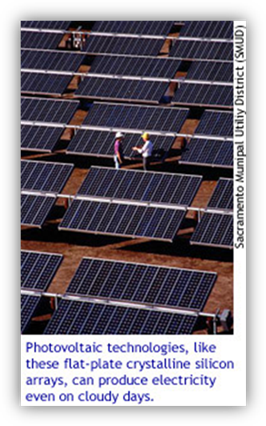 Another use for solar energy is in the production of
electricity. You may have a solar
calculator or a toy that operates with a solar cell. Call boxes along highways have solar cells to
power them. Another name for a solar
cell is a photovoltaic cell. If we look
at the parts of this word, it will lead us to its meaning. “Photo” is a synonym for light, and “volt” is
a way to measure electricity. So,
photovoltaic simply means the production of electricity using light. Sometimes the term “photovoltaic cell” is
shortened to PV cell. These cells use a
thin sliver of silicon in which a small amount of phosphorus is added to half
of the silicon slices and boron is added to the other half. The phosphorus layers have some easily moved
electrons and are known as the n-layers.
The boron layers have the ability to attract electrons and are known as
the p-layers. These two types of layers
are sandwiched together in a PV cell, and some electrons move from the n-layer
to the p-layer. This makes the n-layer
positive because it lost negative electrons.
The p-layer is negative because it gained electrons. When radiant energy strikes this cell, it
causes electrons in the region between the two layers to move toward the
positive n-layer.
Another use for solar energy is in the production of
electricity. You may have a solar
calculator or a toy that operates with a solar cell. Call boxes along highways have solar cells to
power them. Another name for a solar
cell is a photovoltaic cell. If we look
at the parts of this word, it will lead us to its meaning. “Photo” is a synonym for light, and “volt” is
a way to measure electricity. So,
photovoltaic simply means the production of electricity using light. Sometimes the term “photovoltaic cell” is
shortened to PV cell. These cells use a
thin sliver of silicon in which a small amount of phosphorus is added to half
of the silicon slices and boron is added to the other half. The phosphorus layers have some easily moved
electrons and are known as the n-layers.
The boron layers have the ability to attract electrons and are known as
the p-layers. These two types of layers
are sandwiched together in a PV cell, and some electrons move from the n-layer
to the p-layer. This makes the n-layer
positive because it lost negative electrons.
The p-layer is negative because it gained electrons. When radiant energy strikes this cell, it
causes electrons in the region between the two layers to move toward the
positive n-layer.
If
a wire is attached to these layers, it provides a path on which the electrons
can flow and an electric current is created.
This is not a very efficient process, with only about 10 to 14% of the
energy being used to create electricity.
For small portable applications, like calculators, or supplying
electricity in regions where it is hard to string lines, the PV cell can be
useful. Scientists are still working to
make these cells more efficient so they can be used in more places. Energy transformation would be radiant energy
transformed to electricity.
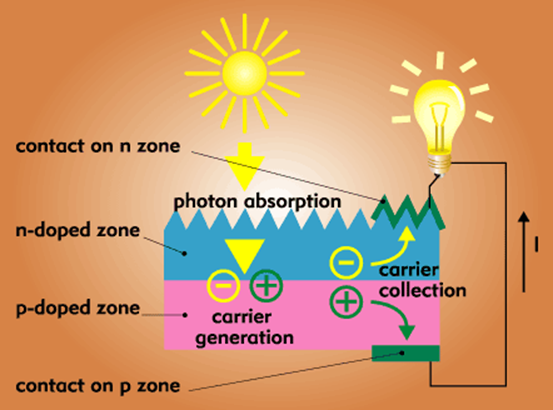
Operation of a photovoltaic cell
|
|
|
|
Solar parabolic troughs heat fluid in
the tube in the center which is then used to heat water to produce steam to
make electricity. |
A solar power tower receives concentrated sunlight from the mirrors
surrounding it. The heat warms the
fluid inside the tower that is used to boil
water to make electricity. |
Another
way to create electricity using solar energy is with devices that concentrate
the sun’s rays. There are three ways
this is being done: parabolic troughs, power towers, and dish/engine systems. These work best in dry, hot areas where
sunlight is plentiful, as in desert areas.
The Mohave Desert in California has the world’s largest parabolic trough. The trough is a
curved mirror that focuses the sun on a pipe in the center of the curve. Fluid inside the pipe is heated and sent to a
heat exchanger where water is turned into steam and drives a turbine attached
to an electric generator. Power towers use large rotating mirrors
that follow the sun’s path. The sunlight
is focused on a fluid-filled panel. The
fluid is then sent to heat water in the same manner as the parabolic
trough. Dish/engine systems have
mirrors shaped like satellite dishes that focus sunlight on a heat engine that
produces electricity. These units are
often mobile and can be moved into remote areas. Energy transformations here would be radiant
to heat to mechanical, and, finally, to electrical.
Solar energy is useful because it is available everywhere, although it is more constant in some climates than in others, and it creates no pollution. However, the manufacturing of PV cells can create some pollution. Also, large solar farms in desert areas must be well-managed so they do not affect the desert ecosystem.
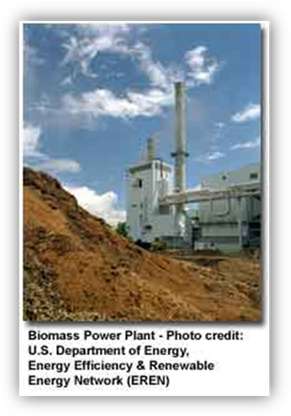
Biomass
Biomass is any matter that comes from a living source,
whether plant or animal. It is probably
the oldest source of energy. For
thousands of years, people have been heating and cooking with wood. It is also the most used source of the
renewables, supplying about 3.6% of our current energy needs. The energy in biomass is stored chemical
energy placed there, originally, by the process of photosynthesis. If the biomass is an animal byproduct, it
came from what the animal ate, which can be eventually traced back to
plants. Examples of biomass are wood and
wood wastes like chips and sawdust, agricultural waste like corn cobs and fruit
pits, solid waste or garbage, landfill gas, biogas, and alcohol fuels.
Most
biomass (over 75%) comes from the lumber industry, including paper mills and
saw mills. Often the companies that
create this waste use it to produce heat to generate electricity. This may supply up to one-half of their
energy needs. It also saves on disposal
costs because they are using up wastes.
Garbage which contains biomass and waste plastic and rubber has about
25% of the energy content of coal.
Waste-to-energy plants are power plants that burn garbage to generate
electricity or to generate heat. This is
a more expensive way to generate electricity, but it reduces the amount of
material we add to landfills.
Landfills
themselves generate methane gas through the action of bacteria and fungi. This gas must be trapped because it can cause
explosions and fires, and it also contributes to global warming. The gas is either burned off into the air,
which releases carbon dioxide or it is used as natural gas once it is
purified. A plant in Florence, Alabama,
does just that and pumps it into the city’s gas lines. Although burning this gas creates carbon
dioxide, methane is a greater threat to global warming than carbon
dioxide. Also, since this gas came from
a recently living plant that used carbon dioxide for photosynthesis, it is
simply completing a cycle, and the carbon dioxide will soon be used again in
green plants.
Another
way to produce methane from biomass is with biogas digesters. These are
airtight containers or pits lined with steel or bricks. Wastes are put into them and fermentation
occurs in the absence of oxygen. The
result is methane gas that is safe for cooking, heating, and lighting. These digesters hold great promise for third
world countries as an energy source.
Using digesters may help slow deforestation and reduce air pollution,
and the material left can be used to fertilize fields for agriculture.
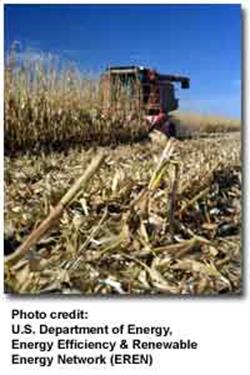
Harvesting corn to make ethanol
Ethanol
can be made by using biomass. Ethanol is
a clean-burning alcohol that can be used as a gasoline additive producing a
cleaner burning gasoline. There are two
processes that can be used. One is fermentation, using yeast to convert
sugars and starch in a plant, generally corn, to alcohol. This is the same process used to produce
wine, beer, and liquor. The other
process, which is still in the development stage, is using enzymes to break down cellulose in woody fibers that can then be
converted to alcohol. An enzyme is a
chemical found in organisms that makes a reaction occur more quickly. This process would also use more of the
plant. Biologists are developing
fast-growing trees which could be used as a source of cellulose, and would be
ready to harvest in ten years. Another
source is perennial grasses that could be harvested twice a year and used for
ethanol production. Perennial plants are
those that live for many years. These
plants could also prevent soil erosion, since they would be mowed and not
totally destroyed when harvested. These
plants require less fertilizer and attention than corn. Today there are over 50 factories that make
ethanol in the U.S., and more are being planned.
Another
source of fuel using biomass is biodiesel.
In this case, ethanol is mixed with vegetable oil, animal fat, or
recycled cooking oil. It can be used directly in diesel engines or added to
gasoline to reduce emissions. Just think
of all the cooking oil that is disposed of by fast-food restaurants that could
be used to fuel vehicles instead of being thrown away. Energy conversion, in all of these fuels, is
from chemical to thermal.
Hydropower and Ocean Power
The
second most-used renewable energy source in the U.S. is hydropower. Hydropower is harnessing the mechanical
energy of falling water and converting it to electricity using turbines and
generators. Years ago hydropower was
used to grind grain, drive sawmills, and pump water using water wheels. You may have seen water wheels at an old
grist mill. There are some still in
operation at historic sites. The wheel
has pockets in it which catch flowing water, often from a mill pond that is
somewhat higher than the wheel. As
gravity lowers the wheel, the mechanical motion is used for the purposes stated
above. Today there are other ways of
doing these jobs, but we still use the power of falling water, either from
natural waterfalls or dams, to produce about 8% of our electricity. It is the largest renewable source used to
produce electricity. In Oregon and
Washington states it supplies 85% of the electricity!
|
|
|
Dams provide potential energy differences |
Niagara
Falls was the site for the first hydroelectric power plant in the U.S. Built in 1879, this plant took advantage of a
natural waterfall. Using natural falls
severely limits the location of hydroelectric plants. However, dams can be built to provide an
artificial reservoir to store water at a higher level than the dam and has the
same effect. In either case, a large
tube, called a penstock, carries the falling water to the turbine. This mechanical energy is then transferred to
generators to create electrical energy.
Two factors, the height the water drops and how fast the water is
flowing, determine the amount of electricity that can be produced.
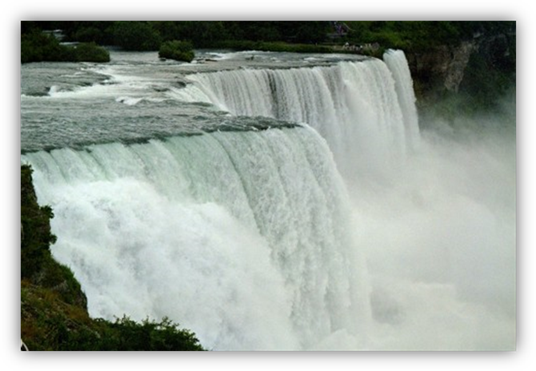
Huge amounts of potential energy
are released as water flows over Niagara Falls.
The
biggest advantage to hydroelectric power is energy can be stored in the water
behind the dam. This is gravitational
potential energy because the water has the ability to fall to a lower level. This water can be stored indefinitely and
released only when electricity is needed.
Electricity, once generated, cannot be stored but must be sent over
wires to homes, businesses, and factories.
Hydropower is also much more efficient than using fossil fuels to
produce electricity. Hydropower plants
run more often than thermal plants and it is the cheapest way to generate
electricity. No fuel needs to be
purchased since rain and snow continually replenish the water in the river or
reservoir.
There
are some disadvantages, however. The
creation of a reservoir disrupts the ecosystem, and some animals may die or
have to relocate. Silt at the bottom of
the river may be stirred up releasing toxins placed there earlier. Water temperatures will be changed since the
reservoir is deeper than the original water source. Unless fish ladders are constructed beside
the dam, fish, such as salmon, that must go upriver to lay their eggs are
prevented from doing so. But, with care,
hydroelectric power plants can produce reliable, cheap, and non-polluting
energy.
The
future for development of more hydropower is limited because the best sites are
already in use. These could be expanded,
and dams that are now used for flood control or recreational purposes may be
able to be converted to hydroelectric power plants.
The
oceans cover 70% of the earth; they are abundant and nonpolluting and can be a
source of electricity. One way is to
harness the mechanical energy of wave action.
The best spots for this type of device are in western Scotland, northern
Canada, South Africa, Australia, and the northeastern and northwestern United
States. Waves result from winds that
blow across the surface of the ocean.
Devices that harness wave power can be either onshore or offshore. Those that are on the shore are of several
types. One uses the waves to push and
pull air through a pipe. The moving air
moves the blades of a turbine. Another
device uses a tapered channel to feed a reservoir behind a dam, but is not in
operation at this time. A third uses a
rectangular box with a flapping opening that powers a generator. Offshore devices include a pump that operates
by the up and down action of waves which creates water pressure to turn a
turbine. Another type uses special
plastic streamers that create electricity when they are moved about. These are used to power buoys, to recharge
robot subs, and possibly can be used to power communications and desalination
plants.
More
success has been achieved using the energy of tides. Tides are the changing levels of ocean water
on shore due to the pull of the moon and sun on the oceans and are repeated
four times a day. In order to work
properly, the difference in tides must be about 10 to 16 feet. There are a limited number of places on earth
where this occurs, namely Brittany in France, Nova Scotia in Canada, and
possibly the northeastern and northwestern U.S.
The oldest installation is in France and has been in operation since
1968. A low dam called a barrage is built. When the tide comes in, one-way gates, called
sluices, let the water flow behind the dam.
As the tide goes out, water is released through turbines as it flows
back out to sea.
|
|
|
Tidal energy to electricity at La
Rance plant in |
|
|
|
This is a typical use of a barrage to
gather water at high tide. As the tide
falls the propellers are turned as the water recedes, creating electricity. |
Several
experimental devices are being tested as possible additional ways to get
electricity from the ocean. A tidal
turbine would operate underwater at speeds of 4 to 5.5 miles per hour. Also a technology called Ocean Thermal Energy
Conversion (OTEC) uses the thermal energy stored in ocean water near the
equator. The water temperature difference
between the surface water and water deep in the ocean must be at least 38
degrees Fahrenheit. The warm water is
used to create steam directly under low pressure or to heat another fluid that
vaporizes easily. The vapor or steam is
used to turn the turbine. Colder water
from deep in the ocean is pumped up to cool the vapor back into a liquid and
the cycle begins again. The process is
only 2.5% efficient partly because it is difficult to pump the cold water
upward. This is also an offshore operation,
so the electricity must be transported to land.
At present, Hawaii has a test plant in operation experimenting with this
process.
Certainly
the future will see some of these uses expanded, and we will be using the vast
energy of ocean water, both its mechanical and thermal energies, to help supply
our energy needs.
Wind
Wind is caused by the uneven
heating of Earth’s surface by the sun, so as long as the sun shines, we will
have wind. However, wind is not
constant, and the amount and speed of wind varies in different locations around
the world. The following map shows the
United States and the regions which have the best winds. As you can see, the coastal areas in the
northeast and northwest, Alaska, and parts of the Midwest near the Rocky
Mountains appear to be the best areas.
Ohio has only marginal or poor wind quality except for a small band
along Lake Erie. Areas near water have
more wind because the land heats quicker during the day than the water. This warms the air above the land. As the warm air rises, it is replaced by the
cooler air over the water. This cool
breeze inland can be a welcome relief from heat for those living in coastal
areas. At night the situation is
reversed because the land cools more quickly than the water. The air above the water is warmer and rises
and air from the land moves out to replace it.
Both of these situations create wind.
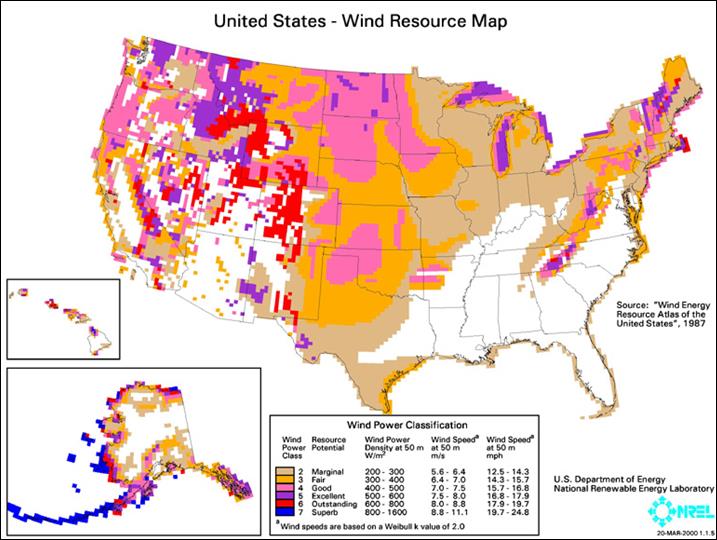
The
productive use of the wind has been documented over a long period of the
world’s history. Egyptians used the wind
to sail ships on the Nile River over 5000 years ago. The early Persians, in what is now Iran, used
windmills, but we probably associate windmills with Holland, where they helped
that country become an industrialized nation in the 1700’s. Early American pioneers used windmills to
grind grain, pump water, and saw wood, but it wasn’t until the oil embargo in
the 1970’s, when oil became expensive and in short supply, that alternative
energy sources began to be seriously investigated.
Today,
wind machines are used almost exclusively to generate electricity. The blades are made of fiberglass or other
high-strength material. As the blades turn
when the wind strikes them, they turn a generator to produce electricity. There is only one conversion of energy – from
mechanical to electrical. Several
designs have been tried. However, the
vertical Darrieus machine is not in use at this time. Named after its French designer, it needs no
tower or yaw mechanism to keep it facing the wind, and the generator can be
located on the ground where it is easier to maintain. But the air speed is close to the ground, it
needs guy wires to hold it up, its efficiency is low, and to replace the main
bearing, it must be totally disassembled.
This machine is only about 100 feet tall and 50 feet wide.
Wind Machine Designs
|
|
|
|
|
Horizontal
axis into the wind machine |
Darrieus
horizontal wind machine |
Horizontal
axis facing away from the wind |
Two
types of wind machines in use are both horizontal; one has the propellers
facing into the wind and the other away from the direction the wind is
coming. They are very tall, about as
high as a 20-story building and have blades about 200 feet across. The most commonly used one has the blades
facing into the wind. This is done with
a tail on a small machine or a yaw mechanism to achieve this on a large
machine. See the diagram below for the
description of the parts of a wind machine.
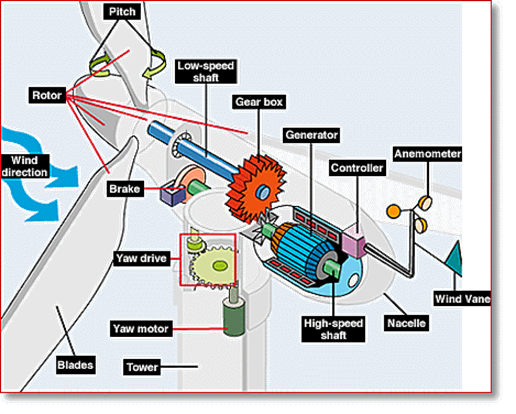
Main parts of a horizontal
wind machine that operates into the wind.
Rotor: blades and hub
Brake: stops rotor in an emergency
Generator:
produces
electricity
Controller:
starts the
generator when wind speeds are 8-16 mph and shuts it off when speeds are above
65mph to
avoid overheating
Anemometer: reads the wind speed
Wind
Vane: tells wind
direction
Yaw
drive and motor: keep rotor
into the wind
Pitch: the twist of the blades that determines
speed of wind that will begin to turn the blades
These
machines occupy a large amount of land, about 2 acres each, but farmers can
graze cattle or grow crops under them.
They are about as efficient as coal-fired plants, but, of course, have
none of the associated water or air pollution problems. The biggest problem is they can injure wild
birds that try to fly near them. Today
only about .1% of our electricity comes from wind power, about the same amount
as from solar power. California,
however, produces 1% of its electricity from the wind, partly because their
state government supports the development of renewable energy sources.
In
the future, there may be more wind machines.
It is estimated that half of the country could use wind machines that
would serve over half of the homes in those areas. If new technologies bring the price down or
people are willing to pay a little bit more for their electricity if it is from
a renewable source, wind power may just take off. One of the experimental technologies is called
the WARP system. It has no blades and
looks like a stack of wheel rims. Each
surface of the rim has a generator mounted on it. The shape of the rims causes the air to flow
past the generators. It is going to be
used to power offshore oil platforms and wireless telecommunication
systems. In the future, this design
might be built right into buildings to supply electricity for that site.
Geothermal Energy
|
|
|
Magma
heats underground water that is vented as steam in this volcano. |
Geothermal
energy, as the name implies, comes from heat within the earth. Deep inside the earth is a layer of hot
molten iron. Above this is a layer
thought to consist of magma or molten rock and solid rock. Then there is the crust, which is the
surface. The crust is broken into areas
called plates, and between these plates are cracks where the molten magma can
escape as volcanic eruptions, or water heated by the magma can escape as hot
springs, mud pots, or geysers. Sometimes,
the hot water is simply trapped underground.
This is renewable energy because, as long as the earth has molten magma
and iron and rain supplies ground water, this energy source will not end.
Finding
geothermal sources is not easy unless the warm water or magma comes from the
ground. Otherwise, geologists must study
aerial photographs, geological maps, and the chemistry of the water and soil
for trace minerals before drilling a test well.
The hottest geothermal regions are along the major plate boundaries
where earthquakes and volcanoes are concentrated. One such region is the Ring of Fire which
circles the Pacific Ocean.
For
centuries hot water springs have been used for bathing, cooking, and heating
and are still being used for these purposes today. Heating can involve heating buildings or
using the heat in greenhouses or in fisheries to increase the growth rate of
fish and amphibians. Other uses are for
pasteurizing milk or drying foods or lumber.
Today, we use geothermal energy for electricity production as well. Most geothermal plants use flashed steam to run a turbine. When released from underground, the
superheated water explosively boils into steam.
After running through the turbine, the steam is condensed into water and
sent back into the earth to be reheated.
Some factories use dry steam
as it shoots from the earth. In this
factory, a rock catcher catches rocks that are blown out to protect the
turbine. The first factory using
geothermal energy to produce electricity was in Lorderello, Italy, in
1904. It is still in use today. In California a similar plant has been
producing electricity since 1960. Binary power plants transfer the heat
from the hot water to another liquid that boils at a lower temperature. This vapor then runs the turbine. The hot water is in a closed system and is
returned to the earth to be reheated.
The advantage of this system is it can use geothermal water that is not
boiling. Some factories use more than
one method. These are called hybrid
power plants. One such power plant
supplies the big island of Hawaii with 25% of its electricity. Although geothermal energy only produces .4%
of the electricity in the U.S., California gets 6% of its electricity from
geothermal energy.
|
|
|
|
A binary power plant
transfers thermal energy from one liquid to another in the heat exchanger
then to mechanical and electrical energy. |
A dry steam power plant
transfer thermal to mechanical to electrical energy. |
Heating
with geothermal energy can involve using the hot water to heat other water
through a heat exchanger and sending it to homes throughout an area. Such a factory has been in use in Boise,
Idaho, since 1893. In France 500,000
people use geothermal energy to heat their homes and in Reykjavik, Iceland, 95%
of the buildings use this renewable energy.
Another
use for the heat within the earth is the use of a heat pump. Heat pumps are
heat exchange devices. Below a certain depth, approximately 4 to 6
feet, the earth has a constant temperature of about 52 degrees. Heat pumps transfer this heat inside the
house. Pipes run through the ground with
water and antifreeze in them. Heat is
transferred to the liquid from the ground in winter and is pumped into the
house with an electric pump. Additional
heating of the 52 degree water happens with an alternative energy source, and
it is pumped to the rest of the house or used to heat air that is blown into
the rooms. In the summer, the heat pump
removes heat from the house and transfers it to the earth, making the heat pump
an air conditioner. Although the initial
cost of installing a heat pump is high, the unit lasts for years and costs very
little to operate. Although some
electricity is required to operate the pump, no emissions result from using a
heat pump except for those to produce the electricity at the power plant. Today over 300,000 buildings in the U.S. use
heat pumps.
In
the future, more geothermal power plants may be used. It is estimated that 4% of our reserve energy
can come from geothermal sources. This
is the third highest reserve behind coal and biomass. Power plants emit few emissions, and if
scrubbers are used to wash out the gases dissolved in the hot water, the
emissions are very low. Binary plants
have no emissions so many areas in our country can be used at sites for these
plants, such as deserts, cropland, and mountain forests. As nonrenewable sources increase in cost and
become more scarce, geothermal will certainly be a good alternative.
|
|
|
|
In winter
the heat pump moves heated liquid from the ground into the house. |
|
Other Energy Conversions
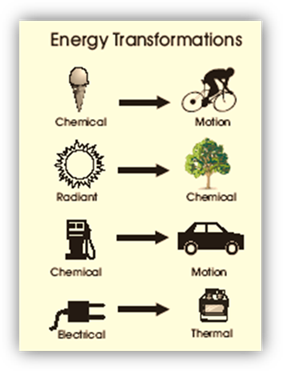
We
have concentrated on energy sources and their conversions to heat and/or
electricity in most of this lesson. What
about transformations of energy that occur within our homes with appliances and
tools? The following diagram shows some
common energy transformations within our everyday lives. The ice cream cone is food, so it has stored
chemical energy which is often transformed within our bodies to mechanical
energy. As we have already discussed,
all photosynthesis changes radiant energy into stored chemical energy as
starches, sugars, and other materials within plants. Gasoline, being a fuel, has stored chemical
energy which is transformed to mechanical energy within the engine of the car
after it is first transformed into heat or thermal energy. Finally, electrical energy is changed into
mechanical energy in a microwave oven (if the microwave has a carousel in it)
and radiant energy (the microwaves) and then into thermal energy. What about a flashlight? Can you name the conversions that occur in it? If you include the energy to turn it on, you
must start with mechanical energy that comes from the chemical energy in our
bodies from the food we eat. Now a
circuit is completed which causes electricity to flow, but wait! What makes the electrons flow? Batteries contain chemicals that produce a
reaction that causes electron flow.
Therefore, we have chemical energy transferring to electrical energy and
then to radiant energy, the light from the light bulb.
Unit Conclusions
Within
this unit we have investigated six different renewable energy sources. Most of these have a form of energy
transformed into at least another energy form before it is used, just as the
nonrenewables do. The difference is
these sources can be replenished and most are much kinder to the environment
because they cause less pollution.
However, they may not be as efficient or as available as most of our
current sources, most of which are nonrenewable sources. As the nonrenewable sources become more scarce
and more expensive and as new technologies and research make renewable sources
more efficient, we will see more and more of our energy needs being met by the
renewables. Much of the increased
efficiency will come from making the energy transformations fewer and easier to
attain.
